I know I asked you, dear readers, to choose between two topics for my next entry: the pommel horse or synchronized diving, or to propose a third option.
One faithful Daily Apple reader posed a third option with this question:

Wu Minxia, synchronized diver from China, wearing the muscle tape on her lower back and on her ankle.
(Photo from NBC Olympics Mobile)
I happen to know the answer to this. It's muscle tape. Athletes have been using it in lots of sports for several years. But I'm glad you asked because it is sort of a mysterious material, and I would like to know more about it, too.

Kerri Walsh during the 2008 Beijing Olympics, wearing black muscle tape on her shoulder.
(Photo by Georgios Kefalas, from Monsters and Critics)

Dr. Kenzo Kase, inventor of Kinesio tape.
(Photo from Kinesio UK)

Kerri Walsh's tape was black, and for a long time, that was the only color of it that I saw. But now you can also get it in beige, blue, and red, as shown here. One roll sells for £7.95 (~$12.35), and a box of 6 rolls goes for £41.50 (~$64.40).
(Photo from Kinesio UK)

They also sell it in a different variety, called "fan cut." I'm guessing this is so you can spread out the ends to cover a lot of surface area more easily. A pack of 50 goes for £46.50 (~$72).
(Photo from Kinesio UK)

Ah, yes. Here is the fan cut option in use.
(Photo from North Coast Medical)

Leryn Franco, javelin thrower from Paraguay, wearing the blue Kinesio tape at the Athens Olympics in 2004.
(Photo from City Centre Chiropractic)

David Beckham sporting the pink Kinesio tape
(Photo from Merchant Circle)

Serena Williams wearing it on her plaguey knees.
(Photo from Skirts N Sports)

Brigitte Foster-Hylton (2155) from Jamaica, in 100M hurdles at the 2008 Beijing Olympics, wearing the Kinesio tape.
(Photo from Skirts N Sports)

One veterinarian in the UK has even used it on horses.
(Photo from Manual Lymphatic Drainage)
The voting for my next entry has been a bit slim. So far, the pommel horse is in the lead. If you'd like to vote on what you'd like to read for my next entry, do so here.
Sources
Kerri Walsh says she'll be ready for Beijing, ESPN Olympic Sports, May 31, 2008
Kate Kelland, Reuters, Scientists skeptical as athletes get all taped up, Calgary Herald, August 2, 2012
Carly Weeks, The latest craze at the Olympics: body tape. But does it do anything? The Globe and Mail, August 2, 2012
Chris Woolston, "The Healthy Skeptic: The sticky issue of kinesiology tapes," The Los Angeles Times, April 4, 2011
Fort Collins Gonstead Chiropractic
Dallas Medical & Chiropractic Clinic, Kinesio taping in Dallas
Kinesio UK
theratape.com, Kinesio Tape
IAAF Athletes Biographies, Brigitte Foster-Hylton
Men's Basketball: OSU Insider, The Columbus Dispatch, March 9, 2011
One faithful Daily Apple reader posed a third option with this question:
Why do the divers have these big red streaks on their backs and legs? One Chinese diver had two parallel streaks on her lower back, one had one thicker one, and another diver had one on her front thigh. What does this mean? What is it made out of? Why doesn't it wash off in the water?

Wu Minxia, synchronized diver from China, wearing the muscle tape on her lower back and on her ankle.
(Photo from NBC Olympics Mobile)
I happen to know the answer to this. It's muscle tape. Athletes have been using it in lots of sports for several years. But I'm glad you asked because it is sort of a mysterious material, and I would like to know more about it, too.
- The first time I remember noticing it for sure was during the Beijing games when beach volleyball medalist Kerri Walsh wore it on her shoulder.

Kerri Walsh during the 2008 Beijing Olympics, wearing black muscle tape on her shoulder.
(Photo by Georgios Kefalas, from Monsters and Critics)
- She had had surgery on her shoulder the year before the games. The surgery attended to problems with her rotator cuff, took out a bone spur, and got rid of some debris and scar tissue from a previous surgery.
- Though her shoulder had healed by the time she got to Beijing, she was wearing the muscle tape to bolster it.
- I was struck by how it seemed flexible enough to conform to her muscles and the shape of her shoulder, allowing more specificity of placement and giving her more range of motion than a wrapped bandage would, and it never came off even though she was doing all sorts of diving into the sand and various other exertions, not to mention a lot of sweating.
- The brand name for it is Kinesio Tape. It was developed by a Japanese chiropractor named Dr. Kenzo Kase.
Dr. Kenzo Kase, inventor of Kinesio tape.
(Photo from Kinesio UK)
- (Actually, there is another brand of this tape out there, called KT Tape. But most people are talking about the Kinesio brand.)
- The tape, according to Kinesio UK, is flexible enough to stretch 30% to 40% longer than its resting length, it allows the skin to breathe, but it will stay on for 3-5 days at a stretch. (a little pun there for you)
- It's made of cotton, which is porous enough to allow moisture to escape through it, which means it will stay on even when it gets wet.
- What makes it stick is a special heat-activated adhesive. When you first put it on, you have to rub it briskly to get the adhesive working, and then it will stick.
- According to the company that makes Kinesio, the tape supposedly allows more blood flow to reach sore muscles by pulling the skin slightly away from the muscle. Its effects are to reduce swelling, pain, and muscle fatigue.
- Kinesio says there's a special way it must be applied, and they train and certify people in how to do that. They say that there are now some 4,000+ certified Kinesio Taping (they put a little R in a circle after this) practitioners in the UK alone.

Kerri Walsh's tape was black, and for a long time, that was the only color of it that I saw. But now you can also get it in beige, blue, and red, as shown here. One roll sells for £7.95 (~$12.35), and a box of 6 rolls goes for £41.50 (~$64.40).
(Photo from Kinesio UK)

They also sell it in a different variety, called "fan cut." I'm guessing this is so you can spread out the ends to cover a lot of surface area more easily. A pack of 50 goes for £46.50 (~$72).
(Photo from Kinesio UK)

Ah, yes. Here is the fan cut option in use.
(Photo from North Coast Medical)
- As far as whether or not it actually works, opinions are mixed. There hasn't been a lot of medical research done on the tape, but what has been conducted has found that there is a short-term benefit in some circumstances, like increased r ange of motion, or a reduction in pain. But long-term, the studies haven't seen results any better than a placebo.
- It should be said that, even though this tape has existed for 30 years, there hasn't been a ton of research that's been able to cover the long-term.
- It should also be said that the placebo effect can be a powerful thing. In other words, if you believe that something will help you, it just might do so.
- Here are just a few other athletes who have used the Kinesio tape:
- Supposedly, some Japanese athletes wore it in the 1988 Seoul Olympics, but you couldn't see it under their clothes.
- Lance Armstrong and his team wore it. Here's what Armstrong says about it in his (and his ghost writer's) book Every Second Counts:
The guy who put us all back together was our chiropractor, Jeff Spencer … Jeff is part doctor, part guru, part medicine man. He had all kinds of strange gizmos and rituals and cures, a remedy for every condition. . . . But Jeff had something that was better than any laser, wrap, or electric massager. He had The Tape. It was a special hot-pink athletic tape that came from Japan and seemed to have special powers. George got a problem with his lower back. Jeff turned him around and started putting hot-pink tape on it. George thought, “How can that help?” But the next day the pain had disappeared – it was gone. We swore by Jeff’s pink tape. He would tape the hell out of anything. You had a tweaky knee? He taped it. A guy would start to get tendinitis and he’d say, “Don’t worry. No problem. We’ll tape it.”

Leryn Franco, javelin thrower from Paraguay, wearing the blue Kinesio tape at the Athens Olympics in 2004.
(Photo from City Centre Chiropractic)
- David Beckham (soccer/football)
- Lots of other famous soccer players including Mario Balotelli
- Tiger Woods (golf)
- Rafael Nadal (tennis)
- Novak Djokovic (tennis
- Justine Henin (tennis)
- Jared Sullinger (college basketball)
- Edgerrin James (professional football)
- Paulo Villar (track)
- Nikola Janovic (water polo)
- Alex Mumbru (basketball)
- Sara Goller (beach volleyball)
- Loads more athletes at the London 2012 Olympics

David Beckham sporting the pink Kinesio tape
(Photo from Merchant Circle)

Serena Williams wearing it on her plaguey knees.
(Photo from Skirts N Sports)

Brigitte Foster-Hylton (2155) from Jamaica, in 100M hurdles at the 2008 Beijing Olympics, wearing the Kinesio tape.
(Photo from Skirts N Sports)

One veterinarian in the UK has even used it on horses.
(Photo from Manual Lymphatic Drainage)
The voting for my next entry has been a bit slim. So far, the pommel horse is in the lead. If you'd like to vote on what you'd like to read for my next entry, do so here.
Sources
Kerri Walsh says she'll be ready for Beijing, ESPN Olympic Sports, May 31, 2008
Kate Kelland, Reuters, Scientists skeptical as athletes get all taped up, Calgary Herald, August 2, 2012
Carly Weeks, The latest craze at the Olympics: body tape. But does it do anything? The Globe and Mail, August 2, 2012
Chris Woolston, "The Healthy Skeptic: The sticky issue of kinesiology tapes," The Los Angeles Times, April 4, 2011
Fort Collins Gonstead Chiropractic
Dallas Medical & Chiropractic Clinic, Kinesio taping in Dallas
Kinesio UK
theratape.com, Kinesio Tape
IAAF Athletes Biographies, Brigitte Foster-Hylton
Men's Basketball: OSU Insider, The Columbus Dispatch, March 9, 2011
VERY interesting! Thank you!
ReplyDeleteThanks, Juliet. I want a ream of the fan tape (put on my fingers while I pound the keyboard, yet another event full of stress and physical abuse).
ReplyDeleteYou're welcome, Layla!
ReplyDeleteAnd yes, Lee, good idea. The keyboard can be punishing. Fan tape would be just the ticket.